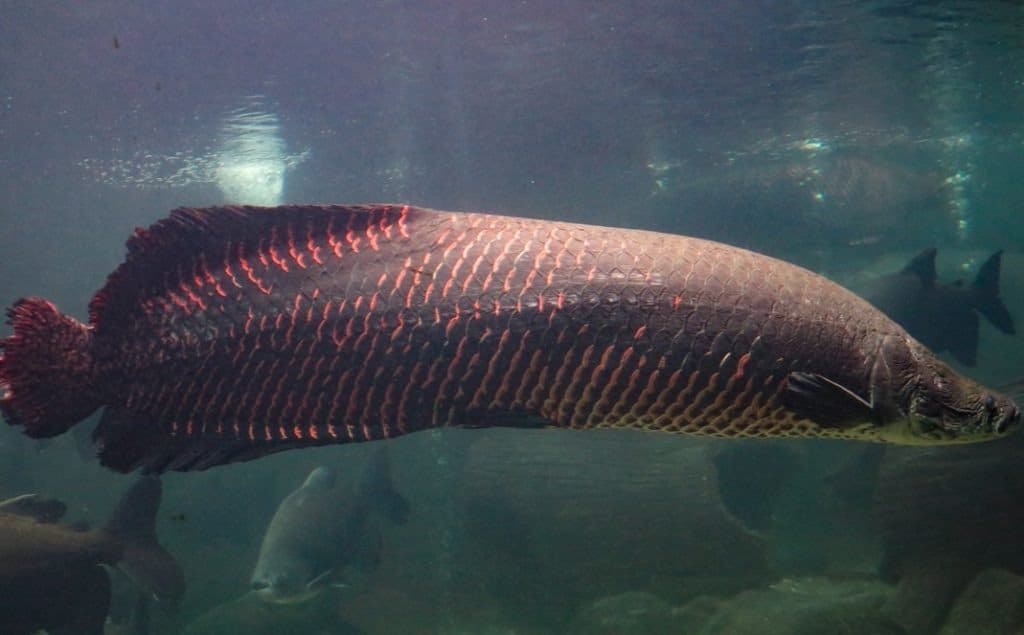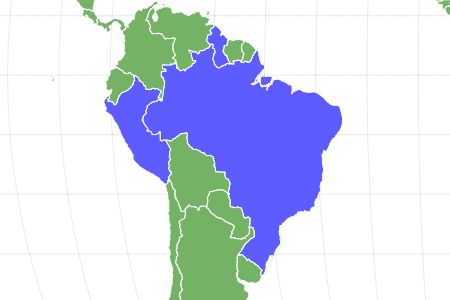Arapaima
.jumbotron {
background-image: url(“https://a-z-animals.com/media/Arapaima-1-400×300.jpg”);
}
}
@media only screen and (min-width: 641px) and (max-width: 920px) {
.jumbotron {
background-image: url(“https://a-z-animals.com/media/Arapaima-1-470×370.jpg”);
}
}
@media only screen and (min-width: 921px) {
.jumbotron {
background-image: url(“https://a-z-animals.com/media/Arapaima-1.jpg”);
}
}
Arapaima
One of the largest freshwater fish
Arapaima Facts
- Prey
- fish, insects, seeds
- Group Behavior
-
- Solitary
- Fun Fact
- One of the largest freshwater fish
- Biggest Threat
- Overfishing, habitat destruction
- Distinctive Feature
- Red tail
- Other Name(s)
- Pirarucu
- Optimum pH Level
- 6.0 – 6.5
- Predators
- humans, caimans
- Diet
- Omnivore
- Type
- Bonytongue
- Common Name
- Arapaima
- Number Of Species
- 4
This post may contain affiliate links to our partners like Chewy, Amazon, and others. Purchasing through these helps us further the A-Z Animals mission to educate about the world’s species..

Spiders that fly! Fish that walk! And 1000+ more incredible animals. Discover them all for FREE
.photo-gallery {
–margin: 0px auto 0px;
–padding: 0px 0px 0px 0px;
}
.gallery-link {
background-image: url(“https://a-z-animals.com/media/Arapaima-1.jpg”);
background-repeat: no-repeat;
background-size: cover;
background-position: center;
height: 500px;
justify-content: center;
text-align: center;
align-items: center;
display: flex;
border: 2px solid #000;
}
.gallery-link img {
height: 50%;
}
@media only screen and (max-width: 768px) {
.gallery-link {
height: 300px !important;
}
}
View all of the Arapaima images!
The Arapaima (also known as the pirarucu or paiche) is an enormous freshwater fish found in the tropical waters of South America.
It is the largest known freshwater fish and can weigh hundreds of pounds. However, they are also caring parents, as the male arapaima cares for his young in his mouth after they hatch from eggs.
5 Incredible Arapaima (Pirarucu) Facts!
- Famous food: Arapaima fish were featured on the famous cooking show Iron Chef America as a secret ingredient.
- Big Gulp: Arapaima fish use the “gulp” method to feed, which means they suck prey in close to the surface of the water using their large mouths.
- Air-breathers: Arapaima fish have oxygen bladders and breathe air for most of their lives – only young arapaima fish have gills.
- Gigantic fish: They are the largest freshwater fish in the world.
- Bony tongues: They are known as bonytongue fish, and their tongues used to crush prey against the roofs of their mouths.
Arapaima (Pirarucu) Classification and Scientific Name
The name of the genus Arapaima comes from the tupí-guaraní word for this freshwater fish. They are also known as “pirarucu” in Brazil, which roughly translated means “red fish.” In Peru, they are called “paiche”.
Arapaima was once thought to be a genus of only one species, Arapaima gigas. Because of this, Arapaima gigas is the most well-researched of all of the subspecies. However, as many as 4 separates species have been discovered, with the most recent one found in the Solimões River in Brazil. Arapaima leptosoma, discovered in 2013, comes from the Greek word leptos, which means “slender”, and soma, which means “body.” Arapaima mapae comes from the Lago do Amapá in Brazil, which is where it gets its scientific name. The final species, Arapaima agassizii was named after famous biologist Louis Agassiz.
Arapaima (Pirarucu) Species
4 species of Arapaima have been classified so far:
- Arapaima gigas: The most well-studied of all of the species. Lives in the Amazon River Basin and is actively fished for its meat, scales, and bony tongue.
- Arapaima mapae: Has a maximum length of 2 meters, and is found in the Lago do Amapá in Brazil.
- Arapaima leptosoma: Discovered in 2013 in the Solimões River in Brazil. It is distinguished from other species by being especially slender.
- Arapaima agassizii: Named after biologist Louis Agassiz. Has fewer rows of teeth than Arapaima gigas. Found in the Brazilian Amazon.
Arapaima (Pirarucu) Appearance
These fish are both long and heavy. They can reach up to 10ft in length, with some sources claiming a maximum length of 15ft (4.7m). They weigh up to 220kg (485lbs). They have copper-green heads and black bodies, with lighter scales in the center. Their tails are covered in red scales, which is where the name (Pirarucu), or “red fish,” comes from.
The fish’s large, bony scales protect them from piranhas and other natural predators of the rainforest. The scales can be up to 6cm long each. They have long, narrow bodies and tail fins that are round and small, which work well for them in the slow-moving rivers that they call home. Their dorsal fins stretch along their backs. Their bony tongues are the defining characteristic of the bonytongue fish or Osteoglossiformes.

SergioRocha/Shutterstock.com
Arapaima (Pirarucu) Distribution, Population, and Habitat
All species are native to South America, particularly in Brazil, Peru, and Guyana. They can be found in various parts of the floodplains of the Amazon River Basin.
They prefer slow-moving, freshwater. This type of water is usually swampy and devoid of oxygen, which does not bother them. These fish breathe air using an oxygen bladder and can stay underwater for up to 20 mins. They can survive outside of water for over 24 hours. Because they need to be breathing air constantly, they do not dive very deeply and stick to the surface of the water.
There is not enough data on the population size of the Arapaima genus, so their conservation status is Data Deficient. Despite this fact, large arapaima is protected by restrictions on harvesting and exporting. This is because large arapaima has been harder to find in the wild, likely due to overfishing and habitat loss.
Arapaima (Pirarucu) Predators and Prey
These fish mostly eat other species of fish found in the slow-moving waters they call home. They are able to position themselves beneath their prey and “gulp” at them near the surface of the water. This action creates a suction-like vortex that forces the prey into the arapaima’s mouth. There, the prey is crushed by their bony tongues and rows of hard teeth.
They are also known to eat fruit and seeds that fall near the water’s surface.
Because of their tough layer of scales, adults have few natural predators. Rainforest caiman is the only creature known to prey on them. Baby arapaima, called fry, are often preyed upon by other species of fish, particularly various species of cichlid.
Humans are by far the largest threat to these fish. They have been considered a food source by local South Americans for countless years, and they are also exported in limited amounts to chefs and kitchens around the world. Overfishing has caused a decline in arapaima populations.
Arapaima (Pirarucu) Reproduction and Lifespan
Arapaima breeding happens in concurrence with the flooding and dry seasons in their habitat. For half of the year, there are drought conditions, and for the other half, there are flooding conditions. During the drought seasons (most often February, March, and April), the female Arapaima digs a nest with her mate. This nest is about 20 inches wide by 8 inches deep and is dug into the soft mud. There, the female deposits up to 50,000 eggs, which the male then fertilizes.
When the young are born, the male arapaima raises them in his mouth. The arapaima fry are a dark color, so the male’s head turns dark to disguise and camouflage them. In order to keep them close, the maile arapaima releases a pheromone from his head that attracts the offspring and keeps them close. Meanwhile, the female swims nearby and guards the young against predators.
Because the eggs are laid in the dry season, the offspring hatch and are able to flourish during the floodwaters of the rainy season. Both parents help aerate the water for them, as young arapaima still breathe will gills. These gills slowly cease to function as they age.
Arapaima (Pirarucu) in Fishing and Cooking
Known as “the cod of the Amazon,” this fish help sustained the local population. One fish can feed many people. The meat is tender, and it has few bones, so it is perfect for grilling and searing.
Because it is treated as a rare delicacy, arapaima has been overfished to some extent. Some restrictions for fishing have been places on the species.
View all 127 animals that start with A
Arapaima FAQs (Frequently Asked Questions)
What do arapaima eat?
Arapaima prey on smaller fish species. They do this by cornering the fish at the surface of the water and sucking them into their mouths using a “gulp” motion. Arapaima has also been known to eat fruit and seeds that fall into the water.
How big do arapaima get?
Arapaima is known to grow between 10 and 15 feet in length, though many do not reach this size.
What is the largest arapaima ever caught?
The largest ever caught weighed 440lbs and was 15 feet long. On average, however, these fish are only about 10 feet long and weigh about 200 pounds.
How do you pronounce arapaima?
It is pronounced “air-ah-pie-ma”.
Are arapaima dangerous to humans?
Though massive in size, these fish are not dangerous to humans. They lack sharp teeth or aggressive dispositions.
What Kingdom do Arapaimas belong to?
Arapaimas belong to the Kingdom Animalia.
How do Arapaimas have babies?
Arapaimas lay eggs.
Sources
- EOL, Available here: https://eol.org/pages/204868/data
- Fishbase, Available here: https://www.fishbase.de/summary/Arapaima-mapae.html
- Britannica, Available here: https://www.britannica.com/animal/pirarucu
- Smithsonian’s National Zoo & Conservation Biology Institute, Available here: https://nationalzoo.si.edu/animals/arapaima
- Animal Diversity Web, Available here: https://animaldiversity.org/accounts/Arapaima_gigas/
















